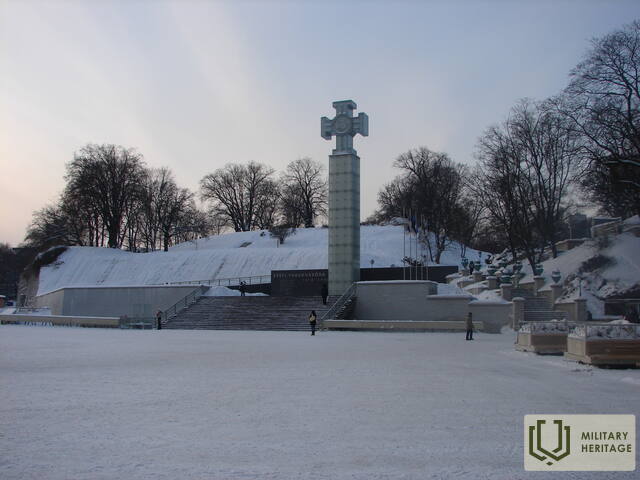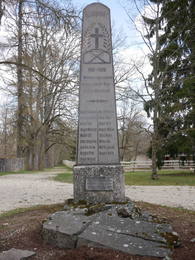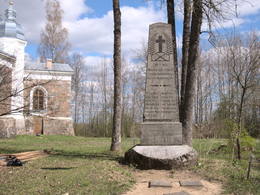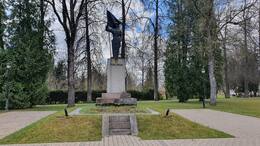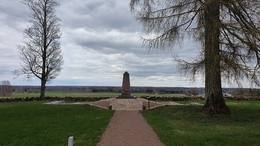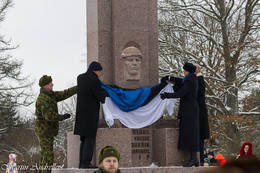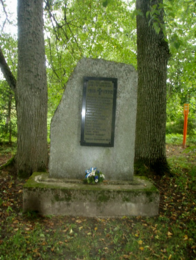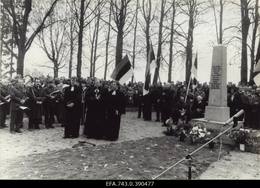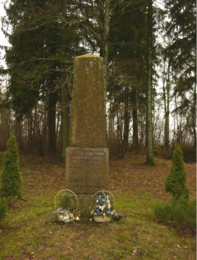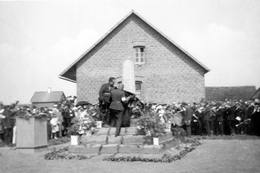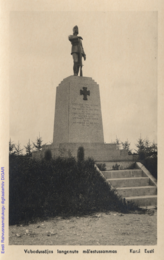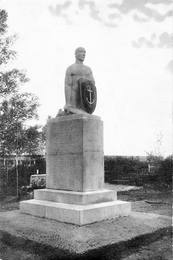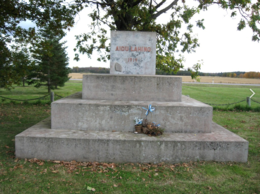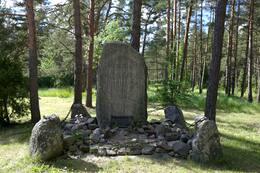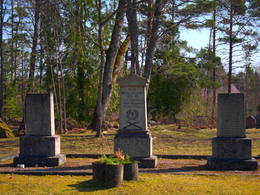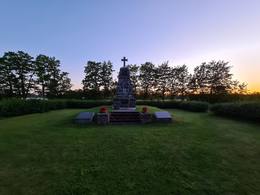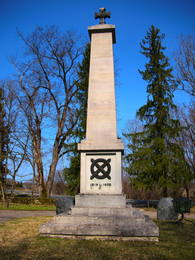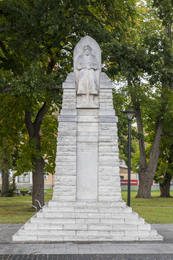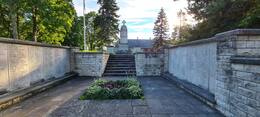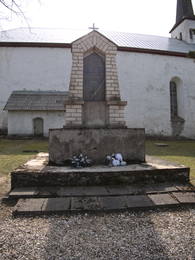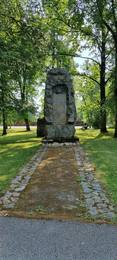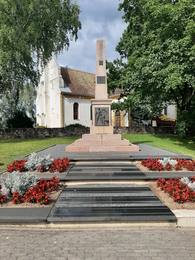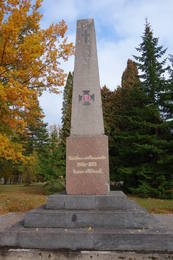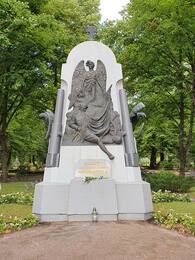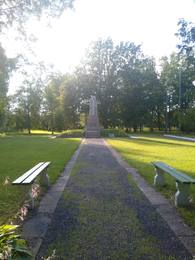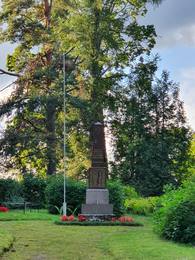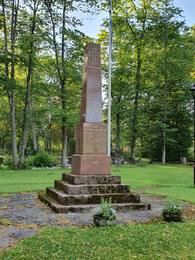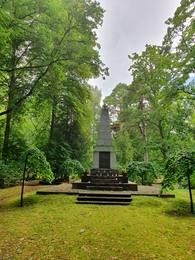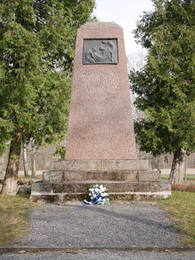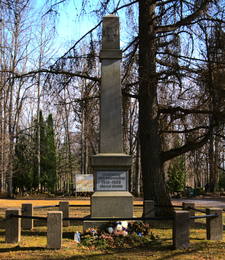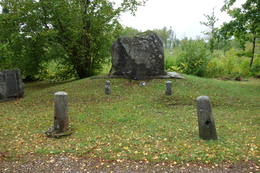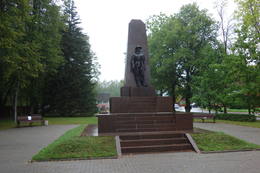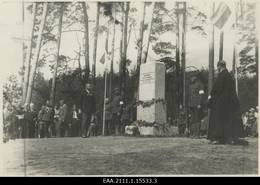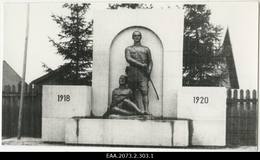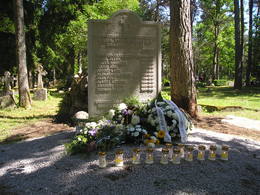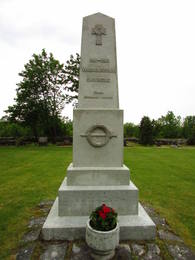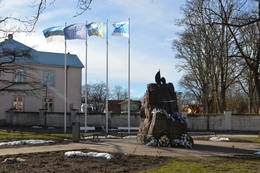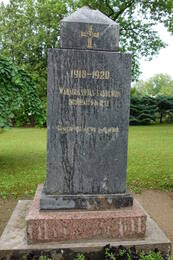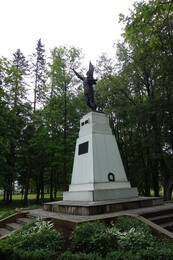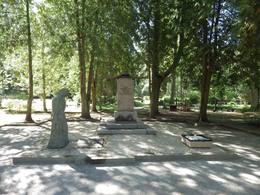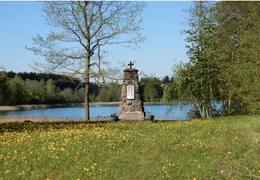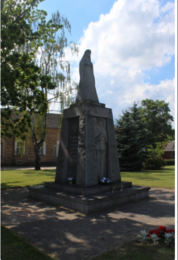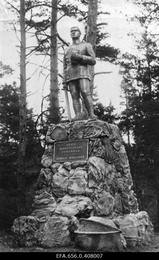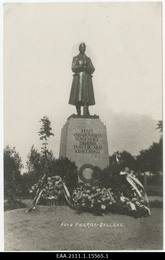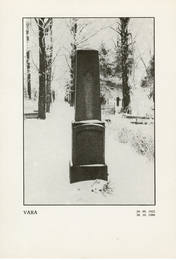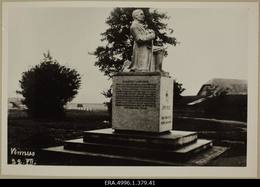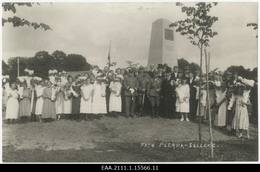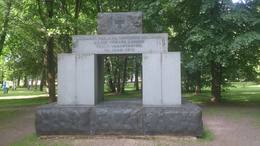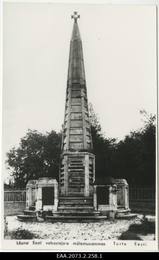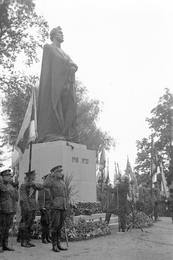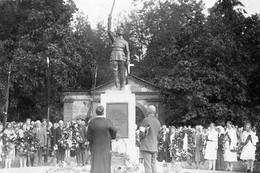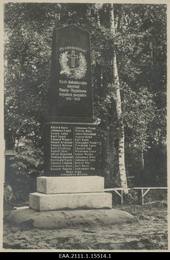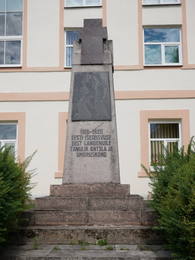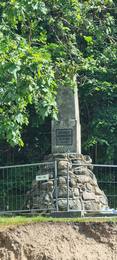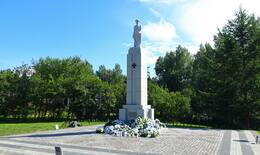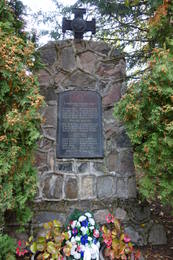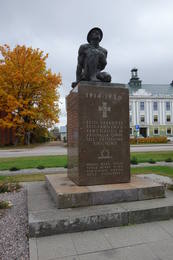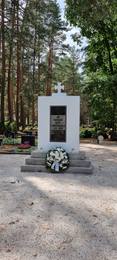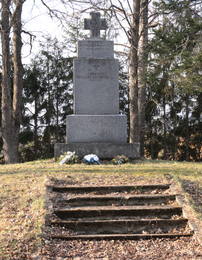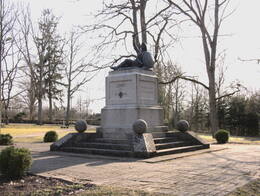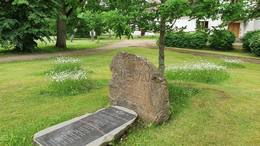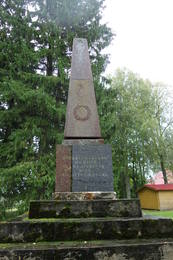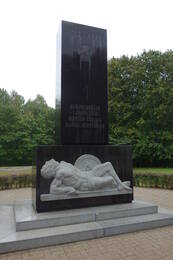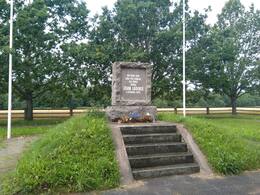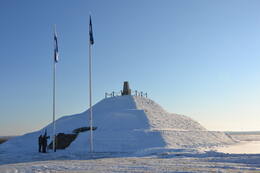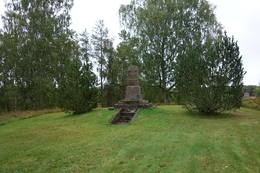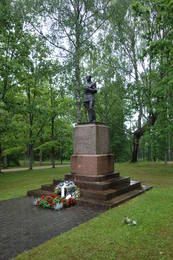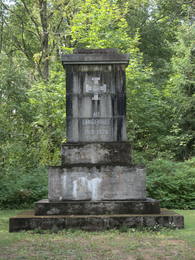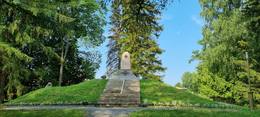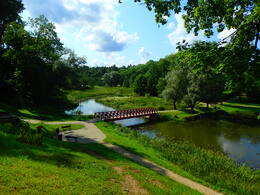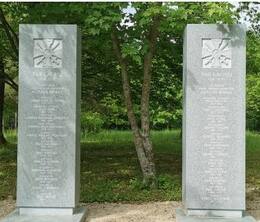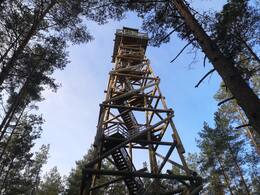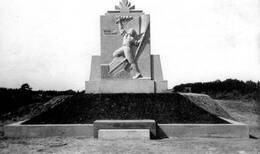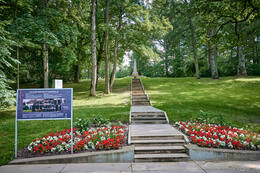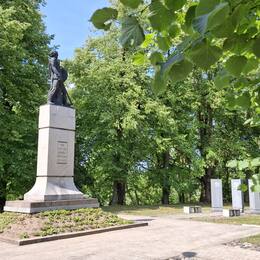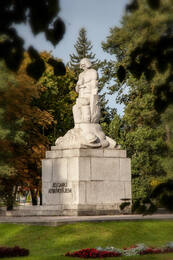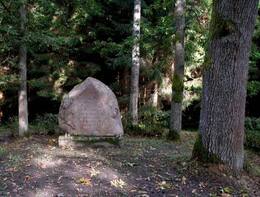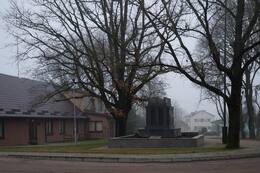War of Independence Monuments
I Wars of Independence
There are monuments across Estonia commemorating those who fell defending their homeland in the War of Independence.
Many new nations were drawn on the world map in the aftermath of the First World War. The Republic of Estonia was among the last of them, having declared independence on 24 February 1918. The newborn republic had to defend its sovereignty in the War of Independence (28 Nov 1918 to 2 Feb 1920), the winning of which is one of the highest achievements in Estonian history.
The monuments tend to be fairly simple in shape, but they have become symbols of Estonian freedom. Over 170 of these monuments were erected during the Interwar Era. Most of these monuments were dedicated to the fallen local men, units or victims of the Red Terror. Others marked battle sites or the line on which the enemy advance was put to a halt.
During the Soviet occupation, most of these monuments to freedom were destroyed, defaced or hidden away, but they didn't fade from memory. As soon as it was possible, the mass restoration of the monuments began; some were restored to their original state, some altered and improved. The majority of these monuments have been restored today. In addition, 12 new War of Independence monuments have been unveiled.
Related objects
Monument to the War of Independence in Kolga-Jaani
This monument near the church in Kolga-Jaani was unveiled on 19 September 1925. It commemorated the 17 Kolga-Jaani Lutherans killed in the war, as the monument in Lalsi was dedicated to the Orthodox fallen from the same parish. This distinction is unique to monuments to the War of Independence. The monument was demolished on 19 June 1941 during the first Soviet occupation. On 29 May 1988 a bronze bust of Villem Reiman, a clergy and one of the most important leaders of Estonian national movement, was unveiled at the site. The monument to the War of Independence was restored and unveiled anew a year later, on 28 May 1989, in the southern part of the church yard. It is a smaller copy of the original monument. Parts of the old monument lie in front of the new one.
Monument to the War of Independence in Tarvastu
This monument was unveiled on 23 June 1937 in the small borough of Mustla. It was demolished on 18 June 1941 during the Soviet occupation before being unveiled anew on 12 July 1942 during the German occupation. In 1948 it was demolished again, and in 1990 the restored variant was unveiled. The monument was restored as per the original, with only some minor alterations. The centrepiece of the monument is its bronze soldier, who holds a flag in one hand and a shield depicting three leopards in the other. He stands on a granite plinth, which in turn rests on a two-stepped footing. The helmet being worn by the soldier is worth mentioning: it was modelled after the famous German Stahlhelm, reflecting the ‘colourful’ supply situation during the War of Independence.
Monument to the War of Independence in Kõpu
This monument, situated in the small borough of Kõpu, was unveiled on 17 September 1933. It was designed by Alfred Leius. Similarly to other monuments, brown granite was used. The monument was demolished on 17 June 1941 and used as building material. It was unveiled anew on 23 June 1989. A large piece of the original monument was placed at the side of the road leading to the monument. A depiction of the Cross of Liberty can still be made out on one of the pieces blown from the original.
Monument to Kehra battle
The Battle of Kehra, which was fought on 4 January 1919, was the first successful armoured train offensive and the turning point in the War of Independence, halting the Soviet advance on Tallinn. Legend has it that General Laidoner, on arriving at the site, personally demanded that the battleground be marked out. This monument was the last to be completed before World War II. It was never officially unveiled – the inauguration which was planned to be held on 23 June 1940 was cancelled due to the invasion of the Soviet forces. The 6.5-metre monument was blown up in late 1944 (although some sources state that this took place as early as 1940) and its stone blocks were used for the construction of nearby summer houses. The railway stop near the monument, which was named Lahinguvälja (Battleground) during the independence era, was renamed Vikipalu in 1957 by the Soviet regime. Following the restoration of independence, the stop was granted its original name. The monument was restored in a smaller form using the remaining parts of the original and was unveiled on 23 June 2000. Restored in its original form, it unveiled anew on 6 January 2019 as part of the centenary celebrations of the Republic of Estonia. The column is adorned with the relief of a soldier's face and reads: "Here the enemy offensive was halted and thus began our forces' march to victory on 4 January 1919".
Monument to the War of Independence in Kaarepere
This monument is situated by the Tartu-Jõgeva road in the village of Kaarepere.
It comprises an irregularly shaped stone standing on a concrete foundation. The dark grey granite tablet mounted on the rock is original; the rest of the monument is a copy.
The tablet reads: "The way paved by your graves leads us to life", while beneath it is a depiction of the Cross of Liberty and the years 1918 and 1920.
The monument was unveiled on 24 February 1933 and unveiled anew on 24 February 1990.
Monument to the Battle of Kõnnu
This monument is located by the Jõgeva-Mustvee road near the small borough of Torma.
Commissioned by the head of the Defence League’s Torma regional unit Leopold Kraus, it was unveiled on 27 July 1930. It was destroyed on 26 October 1948 and its parts buried. On 14 July 1988 the parts were recovered and used to restore the monument, which was unveiled anew on 15 October that year. Some of the original parts lie near the current monument.
Monument to the War of Independence in Saduküla
This monument is situated near the school in Saduküla, 15 km from Jõgeva.
Commissioned by the Härjanurme Company of the Defence League, it marks the point to which the Red Army had advanced by 1919. It was unveiled on 6 July 1930. The monument was dismantled after World War II and the text on it removed by a blacksmith. All of the pieces survived, and the restored monument was unveiled anew on 24 June 1989 thanks to the efforts of local Defence League members.
The tapered plinth supporting the obelisk reads: "Here in January 1919 the bravery of the Estonian people told the red wave pouring in from the east: This far and no further."
Monument to the Battle of Lohusuu
This monument is situated 200 m from the Tartu-Jõhvi road in the small borough of Lohusuu. It comprises an obelisk on a four-step base. The front of the obelisk reads: "This blood-anointed land where my brother met his end till the last of my days shall I strive to defend! The Battle of Lohusuu of the War of Independence 14 December 1918.” To the back of the obelisk is appended the text: “Unveiled on 26 July 1931. Destroyed in 1940. Unveiled anew on 23 June 1990.”
The monument, unveiled on 26 July 1931, was dedicated to those who fell in the Battle of Lohusuu in the War of Independence. The Soviet regime had it taken down and the obelisk was repurposed as part of the monument to the Great Patriotic War in Avinurme. The monument was restored as a copy and unveiled anew on 23 June 1990.
Monument to the War of Independence in Laiuse
This monument is in Laiuse cemetery in the village of Vilina in Jõgeva municipality.
It is dedicated to those from the parish who fell in the War of Independence. It was designed by Anton Starkopf and unveiled on 30 August 1925. It was torn down in July 1941 before being reassembled during the German occupation. It was then demolished in 1954.
The memorial depicted a Grecian-style temple. The two-step foundations supported six fluted Doric columns bearing a massive tapered slab. In the middle was an open space with a tablet listing the names of the dead and a sarcophagus with an effigy of a fallen soldier.
On 22 February 1998 a memorial cross designed by architect Ilmar Kannelmäe was erected on the site of the former monument, which had been destroyed by the Soviet regime. The new dolomite cross features a relief of the Cross of Liberty and the text ‘Rm 14, 7-9’, while the tablets at the foot of the cross on both sides are engraved with the names of the fallen. The left-hand tablet reads: "THE FALLEN OF THE WAR OF INDEPENDENCE", followed by 20 names. The right-hand tablet lists 24 names. The text on the other side reads: "TO THOSE FALLEN IN THE ESTONIAN WAR OF INDEPENDENCE" and "TO THE VICTIMS OF THE WORLD WAR AND THE SOVIET OCCUPATION”.
Monument to the War of Independence in Puurmani
This monument is situated just outside the small borough of Puurmani on the Puurmani-Tabivere road.
Designed by Voldemar Mellik, it was unveiled on 26 September 1926 and depicted a Kuperjanov partisan resting on his gun on top of a granite plinth. The bronze statue went missing during the Soviet era. The plinth was blown up and the mound it stood on was levelled in 1948. A Red Army monument was installed in lieu, which was replaced in 1970 with a monument to the Great Patriotic War. The restored version of the original monument, made by Kadri Metsik, was unveiled anew on 23 June 1992. A new park has been planted around the monument whose trees have been named after those who fell in the War of Independence and other prominent figures from Kursi parish.
Sources:
National Heritage Board registry of cultural monuments. https://register.muinas.ee/public.php?menuID=monument&action=view&id=27111
Monument to the War of Independence in Palamuse
This monument is situated in the New Cemetery in Palamuse.
Designed by Anton Starkopf, it was unveiled on 29 May 1924. The granite obelisk was mounted on a three-step base with the names of 25 people killed in World War I and 32 in the War of Independence engraved along the bottom. The Soviet regime had it demolished in 1952. The new monument, unveiled on 29 May 1994, is an exact copy of the original, fashioned by Paul Uibopuu.
Monument to the War of Independence in Torma
This monument is situated in the cemetery in the village of Vanamõisa, just outside the small borough of Torma.
Designed by Finnish architect Ivari Anttila, the monument was unveiled on 17 June 1923. It depicts a kneeling soldier resembling the Estonian folk hero Kalevipoeg with a sword in his right hand and a shield in his left hand, mounted on a brown granite foundation. The east-facing statue was rotated to face west in 1940 before being rotated back in 1942. The Soviet regime had it demolished in 1948. Some of the parts were buried. The head of the statue went missing and was only recovered years later. An exact copy of the original was unveiled on 23 June 1992. The original cross pattée design was changed to the Cross of Liberty. The remaining original parts are on display in Torma churchyard.
Altar of Victory in Aidu
The Altar of Victory is situated next to the former dairy on Vaadu Farm in Aidu, by the Jõgeva-Põltsamaa road.
It is a monument to the War of Independence. This monument marks the furthest point a Red Army soldier advanced.
The monument designed by Eduard Järve was unveiled on 23 June 1929. In 1932 two oak trees were planted near the monument, one of which has survived. On 4 January 1934 the 2nd Infantry Battalion replanted an oak tree brought from Aidu on the square at Lembitu barracks in Tartu in honour of the battle of Aidu.
On 4 January 1934, the 2nd Infantry Battalion uprooted one of the oak trees in Aidu and replanted it on the square in front of the Lembitu barracks in Tartu in memory of the Battle of Aidu. The monument was blown to pieces in 1940 before being completely destroyed in 1965. The current copy of the original monument was unveiled on 23 June 1989.
Vormsi War of Independence Monument
This monument is a granite boulder standing 2.5 metres high whose front side is polished. It is situated by the western gate of the church yard in Hullo, under some pine trees. The monument was unveiled in 1929, with the date engraved into the rock. This is one of the few monuments to the War of Independence to have survived the Soviet occupation. The fact that the monument is in Swedish and does not have the years 1918-1920 inscribed on it may have helped in this regard. The monument reads: "The inhabitants of the island erected this rock in 1929 in honour of freedom fighters". It is mounted on a stone base. The monument is fenced in by stone bollards with chains.
Monument to the War of Independence in Nõva
The first monument was unveiled in the village of Nõva on 9 September 1928 to commemorate those from the municipality who had fallen or gone missing in the War of Independence. It was a Vasalemma limestone cenotaph with a pediment, mounted on a plinth and crowned with a Latin cross. The monument was destroyed by Soviet occupying forces some time before World War II. It was unveiled anew on 6 August 1989. During the restoration work, two cenotaphs naming those killed in World War II and victims of communism were added to the memorial. The original monument also had the names of those killed in World War I inscribed on it.
The metal wreaths which had once been placed at the foot of the memorial were recovered from the attic of the cemetery chapel in spring 2018. The partially preserved ribbon on one of the wreaths reads: "…fallen soldiers, commemorated by the faithful of Nõva."
It is likely to have been a wreath brought for the unveiling on 9 September 1928 by the congregation in Nõva. The other wreath – laurel branches with silver-edged leaves and one predominant flower – resembles the one depicted in an old photo.
Monument to the War of Independence in Noarootsi
This monument, situated in the cemetery in the village of Hosby, comprises an obelisk on a plinth, both made of fieldstones, crowned with a cast-iron Cross of Liberty. A black granite tablet in Estonian and Swedish is mounted on the front of the obelisk in memory of those from Noarootsi who had fallen or gone missing. It was unveiled on 10 June 1935 before being destroyed in 1948 during the Soviet occupation. The Cross of Liberty on top of the monument was later mounted on the right-hand wall of the side entrance vestibule at Noarootsi church. The monument was unveiled anew on 24 June 1990.
Monument to the War of Independence in Nigula
Situated in the village of Nigula in Lääne-Nigula municipality, this monument, designed by Roman Espenberg (Haavamägi), was unveiled on 14 September 1930. The obelisk stands on a plinth with a stepped footing, topped by a step pyramid and crowned with a bronze Cross of Liberty. The front of the plinth is adorned with a bronze low-relief depicting a soldier caring for his wounded comrade. It was demolished in 1946, but the foundations and bronze details survived. The monument was unveiled anew on 10 September 1989. Its dolomite parts are exact copies of the original, while the bronze parts were restored. The names of 19 people killed in the War of Independence and 61 in World War I are inscribed on the monument. In addition, there is a memorial to those killed in World War II and to those deported next to the monument.
Monument to the War of Independence in Haapsalu
This monument, designed by sculptor Voldemar Mellik, was unveiled on 1 November 1924. The cost of the monument came to 746,000 marks, which was no small sum. It was in part funded by donations, with Mellik pushing back the deadline for them to be made a number of times. A memorial to the fallen from Lääne County, it is an obelisk made from dolomite ashlar in rustic style which supports a relief depicting a soldier standing at attention. It was demolished on 19 June 1941 under the supervision of the chairman of the local executive committee Evald Kaar. After its demolition, the site became a flowerbed with blue, dark blue and white flowers (recalling the colours of the Estonian flag), which were quickly ripped out. In winter 1942 a monument carved from ice was installed here. The monument was unveiled anew on 27 November 1994. Fully restored, it was fashioned by sculptor Vambola Mets and again funded by donations from the kind people of Haapsalu.
Monument to the War of Independence in Kullamaa
This monument, made from Saaremaa dolomite, was unveiled on 11 July 1926. It was situated on a square near the church in Kullamaa, where the memorial to well-known Estonian composer Rudolf Tobias now stands. It was destroyed in 1945 and unveiled anew on 30 September 1989. The current location of the monument is between the former pastorate and the church. The monument comprises a tapered obelisk of both protruding and receding blocks on a stepped footing with a Cross of Liberty on top. The second stage of the memorial was added between 1991 and 1999: a nine-step staircase up to a platform surrounded by roughly finished limestone walls. It stands out from other memorials to the War of Independence due to the fact that after its restoration, tablets in memory of the people killed during the Red Terror and World War II were added to the memorial. The stairs leading to the monument are surrounded by walls listing the names of the more than 300 dead.
Monument to the War of Independence in Martna
This monument to those fallen in World War I and the War of Independence was unveiled in the village of Martna on 6 July 1930. It was subsequently destroyed (by being blown up) on 27 August 1953. It is situated in the local cemetery by the church fence. The monument comprises a tapered brick statue resembling a chapel door mounted on a concrete plinth with a two-stepped footing. At the top of it stands a Latin cross. The monument is inscribed with the names of eight soldiers fallen in the War of Independence. In addition, there are 14 names of those killed in World War I. At its rear, another 40 names are engraved. The monument was unveiled anew on 10 October 1992.
Monument to the War of Independence in Kanepi
This monument is situated next to Kanepi Church. It was designed and fashioned by local sculptor Aleksander Jannes and unveiled on 15 August 1926. It was sculpted from a flat boulder found in the church meadow. The monument stands 4.27 metres high and is crowned with a 76 cm iron cross. It is adorned with a relief depicting a helmet, a bayonet and a laurel branch, with an engraving of the years 1918-1920 (the duration of the War of Independence) above them. The text reads: "Wayfarer, standing here, lest thou forget! We died fighting for this land of Estonians to remain free!" The monument commemorates those killed in the First World War, the War of Independence and the Red Terror. It was restored and unveiled anew on 25 September 1988.
Monument to the War of Independence in Põlva
This monument is situated next to Põlva Church. It was designed by sculptor Aleksander Eller. It was unveiled on 29 July 1928, with its three plaques being added on 2 August 1936. The monument was destroyed during the Soviet occupation in 1946 but restored and unveiled anew on 29 July 1989. Some of the original stone blocks, the sign marked with the years 1918-1920 and the plaques listing those killed in the First World War and the War of Independence survived and were used in the restoration of the monument.
Monument to the War of Independence in Räpina
This monument is situated between the church and lake in Räpina. It was unveiled on 26 June 1927. The monument was disassembled on 27 August 1945 and its parts buried. The parts were recovered on 23 February 1989 and the monument was unveiled anew on 24 June 1989, having been reassembled from its original parts. The obelisk, mounted on a brown granite plinth with three steps, has an engraved Latin cross at the top and a depiction of the Cross of Liberty in the middle.
War of Independence Monument in Pärnu
This monument was designed by Amandus Adamson. It was unveiled in Alevi cemetery in Pärnu on 16 July 1922. Its designer was buried next to it in 1929.
On 15 April 1945 the monument was blown to pieces, which were then buried. The statue of a boy with a garland was buried by local high school girls 175 metres from the monument. Luckily the graves of the soldiers were left untouched.
The garrison cemetery was renovated in 1987 and the parts of the monument (incl. statue of the boy with the garland) were dug up in 1988. On 24 February 1989 the upper part of the monument, which was found buried in its original location, was unveiled with a granite tablet reading: "1918 1920 / HERE WAS UNVEILED, ON 16 JULY 1922 THE MONUMENT TO THOSE / FALLEN IN THE WAR OF INDEPENDENCE / SCULPTOR AMANDUS ADAMSON / DESTROYED IN 1945 / 24 II 1989 P.M.S." The full restoration of the monument and cemetery was completed in stages. The monument was unveiled anew on 17 July 1993.
Monument to the War of Independence in Lihula
This monument in Lihula was designed by Richard Vasard. It was fashioned from red granite, with a grey granite cross in the middle. Below the cross is the text: "To those fallen in the fight for freedom 1918-1920". The cornerstone was laid on 19 May 1935, with the finished monument unveiled on 4 August 1935. It was blown up in September 1947. The restored monument was unveiled anew on 23 June 1993. The monument itself has no tablets: instead, they have been added one at a time to the slopes at its base. The first tablet to be added lists the names of 26 people killed in the War of Independence. Those added since are dedicated to the victims of World War II and the Red Terror. At present, the tablets name more than 200 people from the surrounding municipalities who were killed.
Monument to the War of Independence in Mihkli
This monument is situated in the village cemetery in Mihkli in Pärnu County. It is a stepped and tapered obelisk of polished dark red granite. The top of the front side of the obelisk is adorned with an engraving of the Cross of Liberty. Below this it reads: "To the sons of the Mihkli congregation who died with honour in the Great War and the Estonian War of Independence 1914-1920. The Mihkli congregation is forever grateful.” Beneath it, on all four sides of the obelisk, are inscribed the 96 names of the fallen. These inscriptions are gilded. The monument stands 3.05 metres high.
It was unveiled on 30 May 1926. Unlike most War of Independence monuments, the Soviet regime did not get the chance to destroy this one, as it was hidden in the nearby cemetery with the help of the local pastor. Its restoration turned out to be very simple, as the buried monument was in perfect condition and was simply returned to its original place through the joint efforts of locals in 1988.
Monument to the War of Independence in Pärnu-Jaagupi
In 1922, a monument dedicated to the men from Pärnu-Jaagupi parish (in what is now Põhja-Pärnumaa municipality) who fought in World War I and the War of Independence was unveiled in the cemetery in Pärnu-Jaagupi. The monument was made at Jüri Walk's marble and granite factory in Pärnu. It was unveiled on 22 September 1922 and demolished in 1945. By 1 May 1989, a total of 10,362 roubles had been raised in donations for the restoration of the monument, which was unveiled anew on 18 June 1989. The monument comprises a multi-layered obelisk on a four-stepped base. The gilded contours on the front of the obelisk depict the Cross of Liberty. Below it is the text: "Be ye faithful unto death". The bottom plinth of the obelisk is adorned with a gilded list of the dead entitled ‘To the fallen heroes of Jakobi’.
Monument to the War of Independence in Audru
This monument, situated in the cemetery in Audru, was designed by artist Erich Leps. It was unveiled on 2 July 1939. The monument was demolished in spring 1945. The base of the monument remained intact, while the blocks of the obelisk were thrown in the Audru River.
The monument was unveiled anew on 2 July 1989. The monument is made of dolomite, with the names of 58 people who fell in World War I and 46 in the War of Independence engraved on the rear side.
Monument to the War of Independence in Tori
This monument was designed by Anton Starkopf and fashioned by stonecutter August Pärn. It was unveiled in the village of Tori in Pärnu County on 24 June 1923.
The monument was blown up in August 1945. The resulting rubble was used as filler for the concrete used in the construction of Tori bridge. The damaged low-relief was saved by Nikolai Kõlvart, who hid it in his home.
On 23 February 1989 a white dolomite tablet was placed at the original site of the monument, reading: "TO THOSE FALLEN IN THE WAR OF INDEPENDENCE 1918-1920 FROM A GRATEFUL TORI PARISH". The restored monument was unveiled anew on 30 September 1989. It is engraved with the names of 73 fallen: 21 more than on the original. The monument is made of reddish granite and adorned with a bronze low-relief and decorations.
Monument to the War of Independence in Vändra
This monument was unveiled in the borough of Vändra on 24 June 1922. It was designed by master stonemason Oskar Goldberg. The monument was demolished in 1941. The person responsible is thought to have been the local bell-ringer. It was partially restored during the German occupation: the intact upper part with the depiction of the Cross of Liberty was mounted on a brick base. In 1945 the monument was disassembled and removed to an unknown location. It was eventually found in the late 1980s on the site of the former state-owned farm in Pärivere. A temporary version of the monument was unveiled on 24 June 1989. Some sources claim the upper part of the obelisk with the depiction of the Cross of Liberty was found in the church shed in 2000, allowing for the final unveiling of the restored monument in 2008.
Monument to the Battle of Punapargi in the War of Independence
The Battle of Punapargi was a skirmish between the Estonian 6th Infantry Regiment platoons and the retreating German occupying forces on 23 December 1918 near the village of Punapargi in Pärnu County. It was the only serious armed conflict between Estonians and Germans during the latter's retreat from the country. The reconnaissance platoon of the infantry regiment lost nine men in the battle; three were wounded. The burial of the fallen heroes took place in Pärnu on 26 December with full honours. The funeral procession was attended by more than 2000 people, including a Defence League squad. The Germans lost 22 men, with 30 injured. Those killed were buried in the cemetery in Mazsalaca. The monument to the Battle of Punapargi was unveiled on 12 August 1934. It was blown up in 1950 during the Soviet occupation. The monument was designed by sculptor Martin Saks. During the Singing Revolution in 1988, the monument was put together again and the restored version was unveiled on 15 October that year. It depicts the Cross of Liberty and reads: "Bravery accords victory".
Monument to the War of Independence in Kilingi-Nõmme
This monument in the town of Kilingi-Nõmme was unveiled on 5 June 1933. A statue of a soldier, it was made by sculptor Anton Starkopf and based on Lembito Hansberg, the secretary of the Kilingi-Nõmme Fire Brigade and a War of Independence veteran.
The monument was blown in the early hours of 13 August 1945. It was unveiled anew on 24 June 2008. It commemorates those fallen in both World War I and the War of Independence. It is noteworthy that the bronze soldier is wearing a British-style uniform and helmet. This is indicative of the wide range of supplies used during the War of Independence due to the foreign aid provided.
Monument to the Battle of Reola
This monument is situated in the village of Tõõraste in Kastre municipality. Designed by Anton Sobolev, it commemorates the Battle of Reola, which was one of the turning points in the War of Independence. During the battle, which took place on 16 & 17 January 1919, the Estonian forces thwarted the Red Army’s attempt to capture Tartu. The monument was unveiled on 3 July 1932. After World War II it was knocked down and buried. On 27 November 1988, the monument, now dug up and restored by the Kambja Heritage Association, was unveiled anew.
Monument to the War of Independence in St Paul's Cemetery
This monument is situated in the north corner of St Paul's Cemetery in Tartu.
Designed by sculptor Aleksander Eller and city architect Arnold Matteus, it depicts two soldiers fashioned by Amandus Adamson and was unveiled on 11 November 1934. During the Soviet occupation the sculptures and dates were removed from the monument. On 10 October 2015 a War of Independence memorial was unveiled in the same location, comprising the sculpture ‘Kalev and Linda’ by Mati Karmin and a ceremonial square designed by Mati Karmin and Tiit Trummal with pathways, park benches and directional lights. The monument marks the mass grave of 254 soldiers who died in the War of Independence.
Monument to the War of Independence in Mustjala
This monument is situated in Silla Cemetery in Mustjala, 700 metres from the Silla-Küdema road. It is 160 cm high, including its footing, 90 cm wide and 20 cm deep.
The restored monument was designed by Mati Karmin and fashioned by stonecutter Volli Sai. It was unveiled on 26 June 2011. The monument is dedicated to the 10 brave heroes from Mustjala who fell in the War of Independence. The monument reads:
"GREATER LOVE HAS NO ONE THAN THIS: TO LAY DOWN ONE'S LIFE FOR ONE'S FRIENDS. JHN. 15:13
THE GRATEFUL PEOPLE OF MUSTJALA MUNICIPALITY
COMMEMORATE THE HEROES OF THE WAR OF INDEPENDENCE"
Monument to the War of Independence in Kihelkonna
This monument is situated in the cemetery in Kihelkonna. Its stonework was done by sculptor Mihkel Munk. It was unveiled on 29 September 1934. The monument was completely destroyed during World War II. It was officially unveiled anew on 10 June 1989. The current monument is an exact copy of the original. It forms an obelisk mounted on a three-stepped footing. The front side of the obelisk is adorned with a depiction of the Cross of Liberty, beneath which it reads: "1918-1920 / TO THE VICTIMS OF THE WAR OF INDEPENDENCE / GRATEFUL PEOPLE OF KIHELKONNA". The plinth is adorned with a low-relief of a sword and a wreath. The monument stands 3.75 metres high. The rear side of the obelisk is inscribed with the names of 15 people who fell.
Monument to the War of Independence in Kuressaare
This monument is situated in the centre of Kuressaare at the intersection of Lossi and Lasteaia streets.
It was unveiled in memory of those who fell in the War of Independence (1918-1920). The designer of the monument was one of Estonia’s most famous sculptors, Amandus Adamson, whose best-known work is the Russalka Memorial in Tallinn. Construction began in Italy in 1927. The monument was unveiled in 1928. It was later adorned with two bronze tablets inscribed with the names of fallen and wounded soldiers from Saaremaa. The monument has been demolished twice in its lifetime. The bronze sculpture was restored by sculptor Matti Varik based on old photos of the original.
The front side of the monument reads: "To those who fell in the War of Independence 1918-1920 from the grateful people of Saaremaa."
Monument to the War of Independence in Valjala
This monument is situated in the church yard in Valjala. It was fashioned by Anton Õunapuu. The monument, in memory of the soldiers from Valjala parish who fell in the War of Independence, was unveiled on 24 June 1923. In autumn 1944 (other sources state September 1947) it was blown to pieces. The architect behind the new monument was A. Mänd. The monument was unveiled anew on 23 June 1993.
Certain changes were made to the original design. The dolomite monument forms an obelisk mounted on a stepped plinth, crowned with a cornice cap. Atop it stands a dolomite Cross of Liberty.
Monument to the War of Independence in Priimetsa cemetery
This monument was unveiled in this cemetery in Valga on 11 October 1925. It is found on one of the largest burial sites of the fallen in the War of Independence and is the final resting place for over 300 men. Alas, not all those buried were identified, so the monument bears just 154 names. The monument nevertheless mentions the 152 who were unable to be identified. The monument was knocked down in September 1940 but returned to its upright position in July 1941. After World War II the monument was toppled again and then buried.
It was unveiled anew in the same location on 27 November 1988, restored from its original parts. The monument is modest in design. It comprises a stepped base surmounted by an obelisk. The material used is grey granite.
Monument to the War of Independence in Valga
This monument, in remembrance of freedom fighters from Southern Estonia, depicts a statue of an unknown soldier, his sword sheathed, holding a flag in one hand and the other outstretched, standing on top of a tall plinth. The original monument was unveiled on the 31st birthday of Lieutenant Julius Kuperjanov on 11 October 1925, but was demolished by the Soviet regime on the night of 21 September 1940. It was unveiled anew at its original location on Kuperjanovi Street in Valga on 16 August 2013. The original monument was designed in 1925 by Amandus Adamson, who also oversaw the bronze sculpture's casting in Italy. It was restored to its full size by sculptor Jaak Soans. The restoration was organised by the non-profit organisation VIKP (Permanent Exhibition of Patriotic Education in Valga), the town and county government of Valga and the Estonian War Museum.
Monument to the War of Independence in Rannu
This monument is situated in the cemetery in Rannu. Designed by Voldemar Mellik, it was unveiled on 23 August 1931. In 1949 the Soviet regime had it blown up. In 1976, Kalev Raave organised the erection of the sculpture ‘Mother of Rannu’ at the site of the former monument. In 1991 a memorial tablet was hung on the wall of the church in Rannu in remembrance of the men from the area who had fallen in the War of Independence. At the same time as restoration of the monument was mooted in 2014, the pieces of the monument were coincidentally recovered during renovation work in the cemetery. Unfortunately, the bronze gun, helmet and figure of the soldier on the monument remain missing. The ‘Mother of Rannu’ statue was moved and the restored monument was unveiled anew at its original location on 23 August 2015.
Monument to the War of Independence in Pangodi
This monument is situated on the banks of Lake Pangodi in the State Forest Management Centre recreational area in the village of the same name.
Designed by Voldemar Rätsep, it was unveiled on 23 June 1934. The obelisk-shaped monument was made from fieldstones with a cross-potent at the top. The tablets on the monument were removed in 1940 and the monument itself was taken apart in 1949 and 1950. The restored copy was unveiled anew on 23 June 1990, the granite tablets mounted on it being the original ones. The tablet on the front of the monument reads: "To those who fell in the name of freedom 1918-1920", followed by eight names and ‘Kodijärve municipality’. The tablet on the rear reads: "A noble endeavour will forever shine throughout the ebb and flow of time" and is adorned with a depiction of an oak wreath and crossed swords. In 1996, the original cross was recovered from Lake Pangodi.
The tablets are original.
Monument to the War of Independence in Rõngu
This monument is situated in front of the historic Kõvera tavern (built somewhere between 1807 and 1830) in the small borough of Rõngu.
Designed by sculptor Aleksander Eller, the monument was unveiled on 30 September 1934. The bronze sculpture mounted on its granite base depicts the Estonian epic hero Kalevipoeg defending his mother Linda, symbolising the Estonian nation, with a sword. The sculpture was destroyed in October 1940, but then restored during the German occupation and unveiled anew on 12 October 1941. The monument was fully demolished in 1948. The current monument, slightly altered by Villu Jaanisoo, was unveiled on 21 May 1995. It differs from the original by having the statue of Linda at the top and the statue of Kalevipoeg, resting on his sword, placed in front of the monument.
Monument to the War of Independence in Kambja
This monument is situated in the cemetery in the small borough of Kambja.
Colloquially known as ‘Kambja Jack’, the monument was designed by sculptor Aleksander Eller and unveiled on 27 October 1929. The base of the monument was laid from stones gathered from the farmlands and pastures of the families of the deceased and of locals in Kambja. It is said that the statue of the soldier was modelled after the head of Villemi Farm, MP Jüri Ottas. The statue was pulled down in 1940. The sword was hidden by local schoolboys right there on the hillside, but went missing. The statue was put back on 12 July 1942, but the monument was fully demolished on 16 May 1948. The restored monument, with a new bronze sculpture by Aivar Ennet, was unveiled anew on 23 July 1989. The best-known of the soldiers listed on the monument is Lieutenant Julius Kuperjanov.
Monument to the War of Independence in Äksi
This monument is situated by the Tartu-Jõgeva road in the village of Voldi in Tartu municipality.
Designed by Voldemar Mellik, it was unveiled on 28 June 1925. The cast-iron sculpture depicted an Estonian soldier on guard, wearing winter clothing, indicating the liberation of Äksi, which took place during that season. The statue was demolished in 1945, but the plinth remained. The monument, restored by sculptor Airike Taniloo-Bogatkin, was unveiled anew on 27 August 1989. The current bronze sculpture is an exact replica of the original, but the plinth differs by having a depiction of a sword carved into it instead of the original separate sword on the rear. It is surrounded by a grove of oak trees called the Oak Forest of Liberty, which was planted in 1925.
Monument to the War of Independence in Kuusiku
This monument is in the cemetery in the village of Vara. Erected in memory of the five people from Vara who died in the War of Independence, it was unveiled on 20 September 1925. It was demolished in 1950, but its pieces were successfully hidden away. The monument, restored using the original pieces, was unveiled anew on 30 October 1988. It comprises a three-part obelisk on a plinth. The front side of the monument depicts the Cross of Liberty, beneath which it reads in embossed letters: "The fallen of the War of Independence 1919-1920", followed by the names of the five fallen soldiers. The rear side depicts a Latin cross and reads: "Greater love has no one than this: to lay down one’s life for one’s friends".
Monument to the War of Independence in Võnnu
This monument is situated next to the church in the small borough of Võnnu.
Dedicated to those who fell in World War I and the War of Independence and to the victims of the Red Terror, it was designed by Aleksander Eller. The monument depicts a kneeling soldier on top of a granite plinth. It was unveiled on 22 July 1934. It was blown to pieces in 1945, the plinth buried and the statue of the soldier thrown into a pond. The monument was restored from the original pieces and unveiled anew on 1 September 1990 in its original place. The 4.6-metre monument comprises a greyish-brown granite plinth on a three-stepped footing supporting a sculpture of a soldier kneeling with a sword and hat in his hands.
Monument to the War of Independence in Puhja
This monument is situated in the park in Puhja near the Tartu-Viljandi road. Designed by Anton Starkopf, it was unveiled on 5 July 1925 and is located in the heart-shaped park established in 1920-1921 by local farmers in memory of those who fell in the War of Independence. Despite orders from above, the monument was not blown to pieces in 1950, but only buried. In 1988, at the direction of Andrus Sepp, the monument was dug up and returned to its original position. Only the cast-iron swords on the obelisk's plinth had to be recast. It was unveiled anew on 20 August 1988.
Monument to the Battle of Tähtvere
This monument, designed by Aleksander Eller and commemorating the Estonian victory over the Red Army Latvian Riflemen in the Battle of Tähtvere on 14 January 1919, was unveiled on 3 July 1932. It was demolished in 1940, but restored in 1942. After the war, the Soviet regime had the monument completely destroyed and eventually replaced, in 1957, with a bust of Hans Heidemann, a figure in the workers' and trade union movement. Restoration of the monument was proposed by Enn Tarto, and it was unveiled anew at its original site on 2 July 2006.
Monument to the Liberators of Southern Estonia and Raadi Military Cemetery
This monument is situated on the Nurme Street side of Raadi Cemetery in Tartu.
The monument, which was situated in the cemetery of the Tartu Garrison, was proposed by two-time recipient of the Cross of Liberty Colonel Siegfried Pinding. Each side of the monument represented one of the southern counties of Estonia, with the five smaller pillars representing the towns of Tartu, Valga, Viljandi, Võru and Petseri. Fashioned by Anton Sobolev and Voldemar Mellik but left unfinished due to a lack of funds, it was unveiled on 17 October 1926. After World War II the monument was destroyed and its pieces buried. The original pieces were dug up in 1988 and used to restore the monument, which was unveiled anew on 10 July 1991 near its original site – still unfinished.
Monument to the War of Independence in Tartu
This monument is situated on the right-hand bank of the Emajõgi River by Vabaduse Avenue (between the Vabaduse and Kaarsilla bridges) in Tartu.
Designed by Amandus Adamson, it was unveiled on 17 September 1933 and featured a cast-bronze sculpture of the Estonian epic hero Kalevipoeg leaning on his sword. The monument was removed in 1950, but as people continued to bring flowers and candles to the site, a bust of writer Friedrich Reinhold Kreutzwald was unveiled there in 1952. The restored monument, fashioned by sculptor Ekke Väli based on old photos, was unveiled on 22 June 2003.
Monument to the War of Independence in Maarja-Magdaleena
This monument is situated in the cemetery in Maarja-Magdaleena.
The black granite obelisk, engraved with gilded texts, was unveiled on 20 August 1922. In 1945 the monument was taken down and buried. The obelisk was dug up on 22 June 1988 and unveiled anew on 31 July that year. On 23 June 2020, after renovations, the monument was unveiled for a third time. The front side of the obelisk is adorned with crossed oak branches and a depiction of two swords and a gun. It reads: "Honour to the fallen! To the sons of Maarja-Magdaleena congregation who fell in the Estonian War of Independence 1918-1925." The plinth is inscribed with 31 names.
Monument to the War of Independence in Antsla
Monument to the War of Independence is situated in front of the town hall. This monument is dedicated to the men from the borough of Antsla and the parishes of Vana-Antsla, Uue-Antsla, Urvaste and Vaabina who were killed in the War of Independence. It was designed by renowned Estonian sculptor Juhan Raudsepp. The monument was unveiled on 27 September 1925. It was demolished in August 1945. The largest pieces were buried, while the smaller ones were thrown down a well. It was unveiled anew on 22 June 1993. The restored monument is an almost exact copy of the original that was destroyed by the Soviet forces. The original tablet mounted on the monument was cast in bronze, but the new version is made from black granite. It depicts loved ones bringing flowers to the grave of the fallen. Those from Antsla who were killed are listed on the rear side of the monument.
Monument to the Battle of Munamäe in the War of Independence
This monument, dedicated to the men of the 1st Cavalry Regiment who fought and died in the Battle of Munamäe during the War of Independence, was unveiled in 1932. On 14 June 1941 the monument was buried in sand in separate pieces. It is unclear whether this was done as part of its demolition or rather to prevent it from being demolished in the first place. It was restored during the German occupation by putting the pieces back together, but was demolished once again in 1944. The monument was unveiled anew on 7 August 1988. The cobblestone plinth supports a stone block resembling an obelisk. The front side of the monument depicts the Cross of Liberty, below which reads: "Here fought the 1st Cavalry Regiment during the War of Independence 20 March 1919".
War of Independence Monument for Petserimaa
This monument in Värska was constructed in accordance with the designs and photos of sculptor Roman Haavamäe in 1938 and is unique among the restored War of Independence monuments in Estonia. Originally the monument was to be unveiled in Freedom Park in Petseri, but the Soviet occupation prevented this twice, in 1940 and 1944. It was completed 80 years later and unveiled in a new location in Värska, the new administrative centre of the Setomaa region. It is adorned with the coat of arms of the town of Petseri, as the monument was originally funded by the townspeople. It is dedicated to the many who were killed – some estimates suggest around 350 died in the battles fought in Petseri County. The monument stands five metres high and is crowned with a statue of a man wielding a sword and a shield depicting three leopards.
Monument to the Battle of Orava
This monument was designed by artist Arkadio Laigo and fashioned by master builder S. Põvvat. It was unveiled in the village of Orava in what is now Võru municipality on 15 July 1934.
Initially the tablet on the monument was destroyed in 1941. The monument as a whole met the same fate on 31 August 1945. The tablet and stones were buried at the site of the monument itself.
The tablet and most of the stones were recovered on 18 March 1989. The restored monument was unveiled anew on 15 July that year. In addition to the fallen of the War of Independence, the monument also commemorates those killed in World War I and the victims of the Red Terror during the War of Independence. The monument comprises a round-tipped ‘pyramid’ made from fieldstones, crowned with a large cast-iron Cross of Liberty. Compared to its former location, the monument had to be moved approximately 15 metres and now stands next to the former town hall in Orava, surrounded by cedar trees.
Monument to the War of Independence in Vastseliina
This granite monument in the small borough of Vastseliina in Võru County comprises a statue of a wounded soldier kneeling. It was unveiled in 1931 and destroyed only after the Second World War in 1948, with soldiers throwing the bronze statue into the bushes. This was witnessed by local woman Anna Avara, and local farmers August Soe and Rudolf Palu then hid the statue. It was dug up in 1988 and returned to its original place. It is noteworthy that the soldier is wearing a helmet modelled after either the Belgian or British helmets worn at the time. This is indicative of the wide range of supplies used during the War of Independence.
Monument to the War of Independence in Võru
Võru War of Independence Monument is situated at Võru city cemetry. There are 42 graves in cemetery in Võru which belong to soldiers who were killed in the War of Independence. The names of 36 of those buried here are known. The area reserved for them was fenced off with chained bollards from the side of the old cemetery in 1928 and a monument was erected in the centre. The monument was unveiled on 23 June 1938. It surmounted a three-stepped footing, the upper part of the monument forming two steps topped by the Cross of Liberty. The monument was demolished in 1946 and unveiled anew on 23 June 1988. It was the second War of Independence monument in Estonia to be publicly unveiled in an official ceremony. The restored monument was made from concrete and is much wider than the original. Not everyone in Võru was pleased that the monument was being restored: a month prior to its unveiling, the cemetery was vandalised, tombstones were damaged and graves of the fallen were marred.
Monument to the War of Independence in Pilistvere
This monument is situated near the church in Pilistvere and is dedicated to the 58 men from the parish who were killed in the War of Independence. It was designed by sculptor Aleksander Eller. The monument was unveiled on 26 July 1931. On 19 August 1940 the monument was demolished by order of the Soviet regime, but it was unveiled anew on 12 July 1942. The original monument featured a bronze statue of a soldier. Right before the arrival of the German forces in 1941, the monument was disassembled and taken to Viljandi. Its bronze statue went missing for unknown reasons and the monument had to be restored without it during the German occupation. It was demolished for a second time in autumn 1945. The monument was unveiled for a third time on 28 July 1991. As the bronze statue has yet to resurface, it was replaced with a granite Cross of Liberty. The original memorial tablets are engraved with the names of the 54 men killed.
Monument to the War of Independence in Kärstna
The monument commemorating the Battle of Kärstna and the 18 soldiers killed in it was unveiled on 28 August 1928. It is assumed that the monument was designed by the then head of the Sculpture Department at the State School of Arts and Crafts, Leonhard Pruul. Each side of the monument is adorned with a low relief of a battle scene from the War of Independence. The front of the monument reads: "This far and no further! To the heroes who fought in the battles in Kärstna for the freedom of Estonia. Greater Kärstna". As with many monuments to the War of Independence, this one was also demolished in 1941. The plinth, which survived the initial detonation, was eventually destroyed on 31 October 1944. The monument was unveiled anew in 1989.
Monument to the War of Independence in Suure-Jaani
This monument was unveiled in Suure-Jaani cemetery on 24 June 1926, designed by Amandus Adamson. It depicts the ancient Estonian chief Lembitu, wounded, but still holding his sword aloft. The monument was demolished in 1941 and again in 1950. It was restored and unveiled anew on 23 June 1990. Following the first demolition, the bronze statue of Lembitu was placed in a shed belonging to the local executive committee and returned to its original place during the German occupation. After the second demolition of the monument in 1950, the damaged bronze sculpture, now missing one of its hands, was given to Viljandi Museum. A new bronze sculpture was cast for the restoration of the monument in 1990.
Monument to the War of Independence in Õisu
This monument, situated on the grounds of Õisu Manor, is an unworked fieldstone, brownish in colour and standing a metre high, with the years 1918-1920 engraved on it. Its maker and inauguration date are unknown. The original monument has survived. It was buried in 1940 by students from the dairy school in Õisu, hiding it from the Soviet authorities. It was unearthed and remounted during the German occupation before being buried again in autumn 1944. The monument was unveiled anew on 27 October 1988.
Monument to the War of Independence in Halliste
This monument in the village of Pornuse comprises an obelisk on a plinth mounted on a four-stepped footing. Reddish-brown granite was used as material. The upper front part of the obelisk is engraved with a depiction of the Cross of Liberty. It was unveiled on 29 October 1933. It was blown up in 1945 during the Soviet occupation. The restored monument was first unveiled on 24 June 1991. It was later decided to restore the obelisk as well in line with the original. It was unveiled for a second time on 17 August 1996. The current monument is an exact copy of the original, which was so sturdy that the explosion did not completely destroy it. The remaining part was left untouched during restoration. It can clearly be seen which part is the original and which part has been restored. This unique distinction was achieved using grey granite for contrast. The road leading to the monument is flanked on both sides by rubble from the original. The tablets mounted on the sides of the monument are engraved with the names of 48 people who were killed in the War of Independence.
Monument to the War of Independence in Karksi-Nuia
This monument in Karksi-Nuia was unveiled on 23 June 1936. It was demolished on 16 June 1941 during the Soviet occupation. The monument was unveiled anew on 6 September 2008 at a new location in front of Rahumäe cemetery, half a kilometre from the original site. The change in location was prompted by the fact that the original location is now an industrial site. It had to be restored based solely on old photos, as there was nothing left of the original. Two towering granite blocks were used, standing 3 metres tall. The front of the monument is adorned with a white low relief designed by Hannes Starkopf depicting a fallen soldier.
Place of Birth of General Johan Laidoner
The farmhouse on Raba Farm in the village of Vardja, where General Laidoner was born, has not survived. It is thought to have been destroyed before World War II, as a monument was erected in its place in 1937. The monument was demolished in 1940 and restored in 1990. In recent years people have been regularly placing candles at the old farmstead on the general's birthday, 12 February.
Monument of Paju Battlefield
The Battle of Paju took place on 31 January 1919 during the War of Independence between the Tartu-Valga army group of the Estonian People's Force and the Red Army Latvian Riflemen for control over Paju Manor. The battle resulted in the Estonians gaining control over the strategically important town of Valga and its railway turnout. Julius Kuperjanov, who led the Estonian offensive, was fatally injured in the battle.
This monument was designed by architect Georg Saar. A campaign was organised to raise money for the monument. On 12 June 1938, the cornerstone was laid by General Johan Laidoner. The base was completed in 1940, but the monument itself went unveiled due to the Soviet occupation. On the 75th anniversary of the Battle of Paju on 30 January 1994, President Lennart Meri finally unveiled the monument.
Monument to the War of Independence in Taagepera
This monument is situated in the village of Ala in Tõrva municipality, on land formerly part of Taagepera Manor. It comprises an obelisk, originally a slab in the stairs, with a stepped plinth (the original with three steps) mounted on a stepped base. The front of the obelisk is engraved with the text "HONOUR TO THE FALLEN”; beneath it is a depiction of the Cross of Liberty and the years 1918-1920. It was designed by Tõrva stonemason Richard Tooming. The monument was unveiled on 2 September 1934.
It was demolished in October 1940.
Years later, stonemason Elmar Kling was given the plinth inscribed with the names of the fallen. He contacted the local residents and was commissioned to restore the monument. It was unveiled anew on 12 May 1990.
Monument to the War of Independence in Tõrva
This monument is situated in the park adjacent to Tõrva Gymnasium. It was designed by Aleksander Eller, who also sculpted the bronze statue. The stonework was fashioned by stonemason Richard Toomingas. The monument was unveiled in Tõrva Town Park on 14 October 1928. During the Soviet occupation, a group of young locals is said to have decided to rescue the monument, and on 24 September 1940 hid its bronze statue in the Õhne River. It is uncertain what happened to the statue, since a replica was made as part of the restoration process based on old photos. The monument was unveiled anew on 23 June 1990.
The statue is colloquially referred to as Juku or Jack.
Monument to the War of Independence in Lüllemäe
Monument to the War of Independence is situated at Lüllemäe cemetry. This monument was designed by geodetic engineer Georg Saar and constructed by entrepreneur Jaan Kõiv and stonemason Jaan Nõlvand. It was unveiled on 23 June 1936. It comprises a stone block on a grey granite plinth surmounting a stepped base. The front of the monument is adorned with a low relief of the Cross of Liberty and an inscription reading: "Honour to the fallen 1919-1920". The rear side is engraved with the names of 25 fallen.
It was knocked to the ground in 1941 and unveiled anew on 12 July 1942 during the German occupation. On 10 December 1944 the monument was blown to pieces. The resulting rubble was left scattered around the site until being discarded in nearby bushes in 1982. The base and steps of the monument survived. The restored monument was unveiled on 23 June 1992.
Monument to the War of Independence in Otepää
This monument is situated near the church in Otepää.
It was designed by Voldemar Mellik and fashioned by stonemason Peeter Veeber. The monument was unveiled on 10 June 1928. It was demolished on 17 June 1950 and its parts buried. The obelisk was recovered on 3 August 1988.
Plans for the new monument were drafted by R. Unt. It was unveiled anew on 15 July 1989. The obelisk is from the original; the rest of the monument is an exact replica. The original was engraved with the names of 54 fallen, but now bears only 37 names for unknown reasons. It stands on a stepped base on top of a low hill. The monument comprises an obelisk with a stepped rather than pointed tip. It is crowned with the Cross of Liberty.
Defence Forces Cemetery
The Defence Forces Cemetery, established in 1887, is the resting place of soldiers of different descent who died in Estonia. It has been the site of around 5000 interments. During the War of Independence, a total of 440 Estonian soldiers, 130 White Army soldiers who had fought the Red Army and 150 Red Army prisoners-of-war who had died from illness were buried in the cemetery. The memorial to the fallen in the War of Independence was designed by architect Edgar Johan Kuusik and unveiled on 21 October 1928. During the interwar period, this was the only tomb of the unknown soldier in Estonia and an important memorial to fallen heroes. The monument was demolished by the Soviet regime in 1950. It was restored as an exact copy and unveiled anew on 27 November 2012.
The Bronze Soldier, originally named the Monument to the Liberators of Tallinn, designed by Enn Roos and Arnold Alas, was placed on top of a fictitious mass grave of Red Army soldiers in Tõnismägi in Tallinn and unveiled on 21 September 1947. It was relocated to the Defence Force Cemetery on 30 April 2007. The limestone wall behind the statue was relaid on a smaller scale but retains its original look.
The real berth of the ship "Saratov".
The real berth of the ship "Saratov" is located in Liepāja, Vecā ostmala 59 near the boat docks, but the memorial is located in the immediate vicinity of the special economic zone of Liepaja.
Built in 1888 in Copenhagen in the shipyard "Buvmeistar & Wain" under the name "Leopold II". 1911. In 2010, it was bought by the joint-stock company Russian North-West Shipping and renamed "Saratov", Latvian Aleksandrs Remes became the ship's captain.
In May 1915, when Liepaja was occupied by German troops, "Saratov" was in the port in a damaged condition.
On January 10, 1919, the steamship "Saratov" was taken over by the Provisional Government of Latvia. From April 1919 to July 1919 on the ship "Saratov" after "16. of the April coup" was the Provisional Government led by K. Ulmanis, which was forced to save itself under the protection of the Allied fleet.
On July 8, 1919, after the Provisional Government of K. Ulmanis was brought to Riga, the steamer was used in traffic between Riga, Ventspils and Liepāja.
According to the terms of the peace treaty of August 11, 1920 between Latvia and Soviet Russia, the steamer "Saratov" had to be returned to the Soviet side. On January 2, 1923, the steamers were handed over to the representative of Soviet Russia. On January 15, 1923, the steamer "Saratov" perished near Akmeņraga.
In 1936, the Maritime Department of Latvia sold the shipwreck to a company, which salvaged it and delivered it for scrap to the Liepāja Shipyard.
Misiņkalns Military Heritage Trail
Misiņkalns nature park is located in the town of Aizpute. Misiņkalns is the highest place in the city of Aizpute. Its height reaches 95.4 m. The top offers a scenic view of the city. Misiņkalns nature park was started to be built in the 20th century. at first. The area of the park is currently about 28 ha.
In the territory of the park there are several places and memorials related to the events of the 20th century - the memorial stele of the soldiers who died in the Latvian Freedom Wars - the cavaliers of the Lāčpleš Order, the place of the Holocaust memorial, the place of remembrance of the repressed and the memorial plaque of the fallen red partisans.
In the park, you can get to know the plants and plantations of various rare species, as well as enjoy the untouched nature. Currently, the park is criss-crossed by renovated walking and cycling paths, and there is a motorcycle track on the territory of the park, where Latvian motocross competitions take place.
In order to get to know the cultural and historical heritage of Misiņkalns manor park more fully, we recommend using the services of a guide.
Steles in memory of the knights of the War Orders of Lāčplēš
Twenty-seven knights of the Lāčplēš Military Order are associated with the Aizpute region.
Commemorative stelae of a uniform pattern were erected throughout Latvia in honor of the soldiers who fell in the Latvian Freedom Struggle, in which the text engraving font corresponds to the standard of the heroes' memorial plaques, which is analogous to the engraving of the sandstone memorials of the Riga Brothers' Grave and Central Graveyard.
The granite stelae were created as part of the "Remember Lāčplēšus" project of the Young Guard and Information Center dedicated to the centenary of the Latvian state.
Bumbu hill firewatch tower
Latvian Freedom Struggle memorial site. During the Bermontiade in November 1919, the command post of the Latgale division led by Krišjānis Berķas was located here. 6. The Riga infantry regiment, attacking from Bumbu hill, captured Silver Hill.
Monument to the soldiers of the 10th Aizpute Infantry Regiment of the Zemgale Division
Located on the northeastern side of Daugavpils Fortress Garden.
The monument to the 44 soldiers of the 10th Aizpute Infantry Regiment of the Zemgale Division who fell in the Latvian War of Independence was unveiled in the interwar period - on November 14, 1924, when the Latvian army was stationed in the Daugavpils fortress. The monument was created according to the project of engineer Vilhelms Rīmers with money donated by the soldiers, officers of the regiment and the residents of Aizpute. In the thirties, the territory around the monument was improved, it was fenced, hanging weeping ash trees were planted, flower beds, lawns and lilacs were created.
During the Soviet occupation, the monument was rebuilt: initially, a pedestal for a bust of Stalin was placed on it, and in the 1950s, a bust of Lenin was placed on it, which was later moved to another location.
The renovated monument was unveiled on November 14, 2017. The monument was renovated at the initiative of the association “Daugavpils mantojums” with funds from the Ministry of Defense, the State Cultural Capital Fund, the Daugavpils City Municipality and residents.
In 2024, the territory of the Fortress Garden, where the monument is located, was reconstructed.
Viesīte Freedom Monument
Viesīte Freedom Monument is a symbol of freedom, inde pendence and remembrance, dedicated to the battles of the defenders of Viesīte against the Bermontians in 1919.
On 14 October 1919, soldiers of the Third Jelgava Infantry Regiment, together with a unit of Viesīte-Sauka-Varenbroka home guards, stopped the attack of the Bermontians at Viesīte Vale Hill. As a result of this victory, the advance of Bermontian units into Upper Kurzeme and Latgale was stopped. Viesīte Freedom Monument depicts a freedom fighter, who is greeting the sun with the flag of Latvia in his hands. The words “Brīvība – tautas dzīvība” (Freedom is the life of the people) are engraved on the monument. Sculp tor Voldemārs Jākobsons is the author of the design of the monument, and stonemason Voldemārs Treijs carved the monument in Finnish granite. The monument was unveiled on 11 August 1935. Every year, on Lāčplēsis Day, a torch light procession takes place through Viesīte to the Freedom Monument, honouring the freedom fighters of Latvia who gave their lives and fell for their fatherland
Freedom Monument in Iecava
The Freedom Monument in Iecava, carved in stone by Pēteris Banders in 1936, is located in Iecava Park on the bank of the River Iecava valley. The idea of the monument was initiated by Jānis Lūsis, pastor of Iecava-Lambārte Parish, and a participant of the Latvian War of Independence. The monument is dedi cated to the soldiers of the 4th Valmiera Infantry Regiment who fell in the vicinity of Iecava, and to the Latvian soldiers who lost their lives in the Latvian War of Independence.
During the Soviet occupation, the monument was blown up, however, it was not destroyed and was eventually restored in 1988. In 2018, the monument was included on the List of State Protected Cultural Monuments. On 11 November 2018, a commemorative plaque for five recipients of the Order of Lāčplēsis who were born in the former Iecava Region, was unveiled in Iecava Park. Gen eral Werners Tepfers, Lieutenant Colonel Jēkabs Jurševskis, Captains Nikolajs Pļavnieks and Herberts Tepfers, and Cor poral Jēkabs Klauss were honoured. The granite statue was created as part of the project “Atceries Lāčplēšus” (Remember the Bearslayers) to commemorate the soldiers who fell in the Latvian War of Independence.
Bauska Freedom Monument
The monument is located near Bauska Castle, on the banks of the River Mēmele.
It is dedicated to the memory of all Latvian soldiers who died in the Latvian War of In dependence, and it was built using donations by Bauska residents and organisations. The inscription on the monument reads: “Par Latvijas brīvību kritušiem 1915–1920” (For the Ones Fallen for the Freedom of Latvia 1915–1920), with the lines by the poet Vilis Plūdonis engraved in the monument: “Tik tas ir liels, kas spēj priekš citiem mirt. Kam ausis dzirdēt, tas lai dzird!” (Only he is great, who can die for others. Who has the ears to hear, let them hear!) The monument was unveiled in 1929, with a church ser vice at Bauska Church of the Holy Spirit, an address by the President of Latvia Gustavs Zemgals, and a parade by the home guards, schoolchildren and other organisa tions.
Monument to the Liberators of Jelgava “Lāčplēsis”
The Monument to the Liberators of Jelgava “Lāčplēsis” is located in Jelgava, at Station Park, opposite the Railway Station building. It was opened on 22 June 1932, with the participation of the Pre sident of Latvia A. Kviesis, and was built to commemorate the liberation of Jelgava on 21 November 1919, during the Latvian War of Independence. In 1940, during the first period of Soviet occupation, the monument was not affected by changes. In 1941, when the Soviet occupiers were replaced by the German occupation forces, the head of the German occupation administration, von Medem, who had retur ned to Jelgava (his ancestors were the original builders of Jelgava Palace), did not like the unequivocal symbolism of the monument. On 31 October 1942, the German occupation authorities ordered the author of the monument, Kārlis Jansons, to remove the image of a German knight from the monument. In 1950, the Soviet occupation authorities gave the order for the monument to be destroyed. With the help of a tractor, Lāčplēsis was torn off its pedestal, smashed, and an attempt was made to destroy it in a stone crusher. However, Lāčplēsis proved to be so hard that the crusher broke. The unbroken middle part of the monument was secretly buried in the grounds of a kindergarten. In 1988, a fragment of the monument was found and is now lo cated in front of the Jelgava History and Art Museum of Ģederts Eliass. The monument was restored and inaugurated on 21 No vember 1992. It was created by sculptor Andrejs Jansons, who restored the monument created by his father, K. Jansons.
Memorial stone at the battle site of General Jānis Baložs' brigade
The memorial stone at the site of the battle of General Jānis Baložs' brigade is located in the forest near the Riga - Liepāja (A9) highway, near the Batari house.
The memorial stone was unveiled in 1936 with a solemn ceremony attended by the then Minister of Transport B. Einbergs and other high-ranking Riga officials and the public of Džūkste parish, commemorating the battle that took place here on March 22, 1919. The inscription engraved on the monument reads: “Here, on March 22, 1919, the battle of the 1st Separate Baloži Brigade took place, in which 10 soldiers fell and 28 were wounded.”
The battle took place between the Separate Latvian Brigade and the 10th Soviet Latvian Rifle Regiment, which consisted of 90 percent Latvians. During the freedom struggle, it was one of those battles in which Latvians fought against Latvians. The Bolsheviks had established themselves in the Batari houses. They began to fire on the brigade soldiers who were heading in the direction of Kalnciems. As the fire intensified, the brigade deployed for battle. The main burden of the battle was borne by the Separate Student Company and the Latvian Independence Battalion. As the battle dragged on, a platoon of the student company and the newly formed company of Captain E. Graudiņš, while performing a bypass maneuver, collided in the forest with the enemy, who was performing a similar maneuver. In a fierce battle, which in some places turned into close combat, the enemy was defeated. At this time, the German Miller battery assigned to the brigade opened fire on the Batari houses. After artillery fire, the brigade drove the enemy from his positions in a swift attack.
The newspaper “Brīvā Zeme” (18.05. 1936) published the memories of a former fighter: “The brigade’s cavalry had just ridden out into the open, when they were met by heavy enemy fire. After that, it was clear that they were dealing with very strong enemy forces. The battalions, on the orders of General J. Baložis, deployed and began to fight, entering into close combat, as the bayonets of the brigade’s soldiers decided this two-hour battle into a brilliant victory for the Kalpakians. This battle was of great importance, because it leveled the situation on the front, which had become unsafe because of the Germans, and ensured that the Red Riflemen’s regiments no longer entered the Zemgale Plain.”
General J. Baložs' brigade won the battle, losing 10 soldiers, including Kārlis Barons (1900.8.III – 1919.22.III), the grandson of the father of the Dainas, Krišjānis Barons, who is buried in the Riga Brothers' Cemetery. 50 soldiers of the Soviet Latvian Riflemen Regiment fell in the battle.
Laisvės paminklas Pašiaušėje
Paminklas stovi Pašiaušėje, Kelmės rajone.
1931 m. vietos šaulių būrio vado Stasio Beniulio iniciatyva buvo pastatytas Laisvės paminklas, suprojektuotas įžymaus Kauno architekto Broniaus Elsbergo. Paminklu siekta pagerbti 1919 m. Lietuvos laisvės kovose su bermontininkais ties Pašiauše žuvusiųjų atminimą. 1961-1962 m. komunistinės partijos Šiaulių rajono komiteto antrojo sekretoriaus nurodymu paminklas buvo nugriautas.
Šiandien stovi 1989 m. liepos 15 d., minint Žalgirio mūšio 579 m. metines, atstatytas granito paminklas. Jį atstatyti inicijavo Jonas Čyvas, prisidėjo vietos gyventojai ir Kelmės rajono valdžia, panaudodama kolūkiui skirtas lėšas. Paminklas sudarytas iš granitu dengto postamento su vertikalių ir horizontalių plokščių kompozicija Gediminaičių stulpų motyvu. Pasakojama, kad tarpukarinis paminklo projekto originalas įmūrytas pačiame paminkle.
Laisvės paminklas, sudarytas iš granitu dengto postamento su vertikalių ir horizontalių plokščių kompozicija Gediminaičių stulpų motyvu.
Related stories
The story of a unique military object in Karosta
For years, I have not noticed any sustained interest in the unique places just eight to ten kilometres north of the city centre among the residents of Old Liepaja. But hidden in the thicket of the forest, on the dune bank or on the marsh paths, the historic sites of the Karosta are no less interesting historical facts and stories worthy of long-forgotten legends. One of them - the former 23rd Coastal Artillery Battery of the USSR - will be the subject of this story.
Aizporu half manor in the War of Independence
Aizporu Half Manor, Aizpute district, Kalvene municipality, is the westernmost place in Latvia to which Colonel Oskars Kalpaks' separate battalion retreated.
Halfway between Rudbārži and Kalvenė, on the side of the road, is the Aizpore cemetery. There is a monument and 12 memorials to the volunteer soldiers of Oskars Kalpaka's battalion.
Latvian Army armored train No.5 or "Kalpaks"
Latvian Army Armoured Train No.5 or "Kalpaks" was a light armoured train in the Latvian Armed Forces in 1919.




